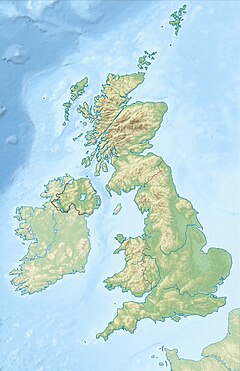
Back المرصد الملكي (غرينتش) Arabic المرصد الملكى ARZ Qrinviç rəsədxanası Azerbaijani Грынвіцкая абсерваторыя Byelorussian Грынвіцкая абсэрваторыя BE-X-OLD Гринуичка обсерватория Bulgarian গ্রিনিচ মান মন্দির Bengali/Bangla Observatori Reial de Greenwich Catalan Harianong Obserbatoryo CEB Královská greenwichská observatoř Czech
 Royal Observatory, Greenwich. A time ball sits atop the Octagon Room. | |
| Alternative names | Royal Greenwich Observatory |
|---|---|
| Observatory code | 000 |
| Location | Greenwich, London, England |
| Coordinates | 51°28′40″N 0°00′05″W / 51.47783°N 0.00139°W |
| Altitude | 68 m (223 ft) |
| Established | 1675 |
| Website | www |
| Telescopes | |
| | |
The Royal Observatory, Greenwich (ROG;[1] known as the Old Royal Observatory from 1957 to 1998, when the working Royal Greenwich Observatory, RGO, temporarily moved south from Greenwich to Herstmonceux) is an observatory situated on a hill in Greenwich Park in south east London, overlooking the River Thames to the north. It played a major role in the history of astronomy and navigation, and because the Prime Meridian passed through it, it gave its name to Greenwich Mean Time, the precursor to today's Coordinated Universal Time (UTC). The ROG has the IAU observatory code of 000, the first in the list.[2] ROG, the National Maritime Museum, the Queen's House and the clipper ship Cutty Sark are collectively designated Royal Museums Greenwich.[1]
The observatory was commissioned in 1675 by King Charles II, with the foundation stone being laid on 10 August. The old hilltop site of Greenwich Castle was chosen by Sir Christopher Wren, a former Savilian Professor of Astronomy; as Greenwich Park was a royal estate, no new land needed to be bought.[3] At that time the king also created the position of Astronomer Royal, to serve as the director of the observatory and to "apply himself with the most exact care and diligence to the rectifying of the tables of the motions of the heavens, and the places of the fixed stars, so as to find out the so much desired longitude of places for the perfecting of the art of navigation." He appointed John Flamsteed as the first Astronomer Royal. The building was completed in the summer of 1676.[4] The building was often called "Flamsteed House", in reference to its first occupant.
The scientific work of the observatory was relocated elsewhere in stages in the first half of the 20th century, and the Greenwich site is now maintained almost exclusively as a museum, although the AMAT telescope became operational for astronomical research in 2018.
- ^ a b Rebekah Higgitt (6 September 2012). "Royal Observatory Greenwich, London". BSHS Travel Guide - A Travel Guide to Scientific Sites. Retrieved 28 April 2017.
- ^ "List of Observatory Codes". Minor Planet Center. Retrieved 28 April 2017.
- ^ "Greenwich and the Millennium". 2015. Retrieved 6 September 2015.
- ^ Robert Chambers, Book of Days
